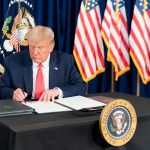Trump wasted no time sharing his thoughts on the recent crash between a military helicopter and an American Airlines jet over the Potomac River, labeling the incident as entirely preventable. In a blunt post on Truth Social, the former president questioned why the helicopter in question appeared to be on a collision course with the jet, which was reportedly following a clear, routine approach to the airport. One has to wonder if the helicopter pilot was perhaps daydreaming about their next covert mission instead of keeping an eye on the sky.
The former president raised several pressing inquiries. For starters, he pointed out that the helicopter seemed to go straight at the airplane for an unnervingly long stretch without any attempt at evasive maneuvers. On a perfectly clear night, with visibility like that of a well-lit Christmas tree, one can’t help but think common sense should have kicked in somewhere in that cockpit. Why didn’t the helicopter ascend, descend, or even take a hard left? It seems that this was a bit of an Air Traffic Control failure waiting to happen.
Moreover, Trump questioned the competency of the air traffic controllers, who apparently opted to ask the helicopter crew if they could see the plane instead of directing them on what to do. One would think that if they had the tools and the training to assist in such situations, they might consider deploying them. Instead, it seems the controllers were playing a game of “Let’s see how this plays out.” Not exactly reassuring for those passengers aboard the commercial flight.
Trump says deadly D.C. air collision should have been preventedhttps://t.co/OP7Vl5P57f pic.twitter.com/d22R12XLge
— The Washington Times (@WashTimes) January 31, 2025
At the time of the crash, the Ronald Reagan Washington National Airport reported pristine conditions. With a temperature hovering around a comfy 50 degrees and visibility stretching for a solid 10 miles, one would think navigating a few airborne vehicles would be child’s play. Yet, here we are, faced with a scenario that could have been easily avoided if someone had decided to take charge. This brings forth the larger question of accountability—the kind of accountability that often seems lost in bureaucracy and red tape.
Tragically, the crash resulted in no survivors. The fallout from this incident will undoubtedly lead to investigations and finger-pointing, but in the end, the only certainty is that it was a sincere disappointment to the families affected. While critics may roll their eyes at Trump’s style, his willingness to question established protocols in instances like these could be the spark that ignites necessary reforms. A little common sense—and perhaps a little less indecision—could go a long way in preventing such avoidable tragedies in the future.




